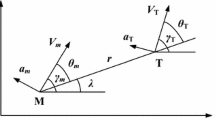Abstract
This paper considers the simultaneous attack problem of multiple missiles against a stationary target. Built upon the classic proportional navigation structure, we propose a consensus-based approach to design the cooperative guidance law. Specifically, we present time-varying navigation ratios for the missiles, which exchange the time-to-go estimates between neighboring missiles via a communication network. For the cases where the communication topology is undirected or in the leader–follower structure with a missile acting as the leader whose navigation ratio cannot be tuned, we show that the proposed cooperative guidance law can solve the simultaneous attack problem. The effectiveness of the theoretical results is finally illustrated by numerical simulations.
Similar content being viewed by others
References
Jeon I S, Lee J I, Tahk M J. Homing guidance law for cooperative attack of multiple missiles. J Guidance Control Dyn, 2010, 33: 275–280
Jeon I S, Lee J I, Tahk M J. Impact-time-control guidance law for anti-ship missiles. IEEE Trans Contr Syst Tech, 2006, 14: 260–266
Lee J I, Jeon I S, Tahk M J. Guidance law to control impact time and angle. IEEE Trans Aerosp Electron Syst, 2007, 43: 301–310
Kim T H, Lee C H, Jeon I S, et al. Augmented polynomial guidance with impact time and angle constraints. IEEE Trans Aerosp Electron Syst, 2013, 49: 2806–2817
Harl N, Balakrishnan S N. Impact time and angle guidance with sliding mode control. IEEE Trans Contr Syst Tech, 2012, 20: 1436–1449
Snyder M G, Li C, Qu Z. A new parameterized guidance law for cooperative air defense. In: Proceedings of the 50th AIAA Aerospace Sciences Meeting including the New Horizons Forum and Aerospace Exposition, Nashville, 2012
Zhang P, Liu H H T, Li X, et al. Fault tolerance of cooperative interception using multiple flight vehicles. J Franklin Institute, 2013, 350: 2373–2395
Wei X, Wang Y, Dong S, et al. A three-dimensional cooperative guidance law of multimissile system. Int J Aerospace Eng, 2015, 1: 1–8
Ou L, Wang Y, Liu L, et al. Cooperative control of multi-missile systems. IET Control Theory A, 2015, 9: 441–446
Olfati-Saber R, Murray R M. Consensus problems in networks of agents with switching topology and time-delays. IEEE Trans Automat Contr, 2004, 49: 1520–1533
Olfati-Saber R, Fax J A, Murray R M. Consensus and cooperation in networked multi-agent systems. Proc IEEE, 2007, 95: 215–233
Li Z, Ren W, Liu X, et al. Distributed containment control of multi-agent systems with general linear dynamics in the presence of multiple leaders. Int J Robust Nonlinear Control, 2013, 23: 534–547
Zhao Y, Duan Z, Wen G. Distributed finite-time tracking of multiple Euler-Lagrange systems without velocity measurements. Int J Robust Nonlinear Control, 2015, 25: 1688–1703
Zhao Y, Duan Z, Wen G, et al. Distributed finite-time tracking control for multi-agent systems: an observer-based approach. Syst Control Lett, 2013, 62: 22–28
Li Z, Ren W, Liu X, et al. Distributed consensus of linear multi-agent systems with adaptive dynamic protocols. Automatica, 2013, 49: 1986–1995
Wen G, Duan Z, Yu W, et al. Consensus in multi-agent systems with communication constraints. Int J Robust Nonlinear Control, 2012, 22: 170–182
Wen G, Duan Z, Yu W, et al. Consensus of multi-agent systems with nonlinear dynamics and sampled-data information: a delayed-input approach. Int J Robust Nonlinear Control, 2013, 23: 602–619
Yu W, Ren W, Zheng W X, et al. Distributed control gains design for consensus in multi-agent systems with secondorder nonlinear dynamics. Automatica, 2013, 49: 2107–2115
Zhang Y, Yang Y, Zhao Y. Finite-time consensus tracking for harmonic oscillators using both state feedback control and output feedback control. Int J Robust Nonlinear Control, 2013, 23: 878–893
Hu G. Robust consensus tracking of a class of second-order multi-agent dynamic systems. Syst Control Lett, 2012, 61: 134–142
Ren W, Beard R W, Atkins E M. Information consensus in multivehicle cooperative control. IEEE Control Syst Mag, 2007, 27: 71–82
Wang Q, Perc M, Duan Z, et al. Delay-induced multiple stochastic resonances on scale-free neuronal networks. Chaos, 2009, 19: 023112
Wang Q, Duan Z, Perc M, et al. Synchronization transitions on small-world neuronal networks: effects of information transmission delay and rewiring probability. Europhys Lett, 2008, 83: 50008
Olfati-Saber R, Murray R M. Consensus problems in networks of agents with switching topology and time-delays. IEEE Trans Automat Contr, 2004, 49: 1520–1533
Yu S, Yu X, Shirinzadeh B, et al. Continuous finite-time control for robotic manipulators with terminal sliding mode. Automatica, 2005, 41: 1957–1964
Acknowledgements
This work was supported by National Natural Science Foundation of China (Grant Nos. 11332001, 61473005, 91216304).
Author information
Authors and Affiliations
Corresponding author
Additional information
Conflict of interest The authors declare that they have no conflict of interest.
Rights and permissions
About this article
Cite this article
Zhou, J., Yang, J. & Li, Z. Simultaneous attack of a stationary target using multiple missiles: a consensus-based approach. Sci. China Inf. Sci. 60, 070205 (2017). https://doi.org/10.1007/s11432-016-9089-7
Received:
Accepted:
Published:
DOI: https://doi.org/10.1007/s11432-016-9089-7




